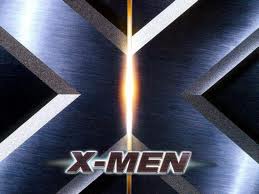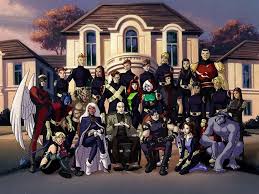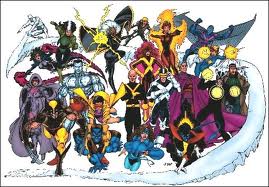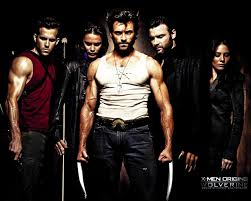X-Men
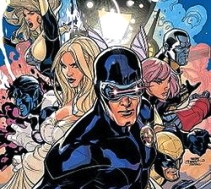
X-Men S-2 E-5 “Repo Man”
X-Men The Animated Series: Season 2 Episode 5 “Repo Man.”
 Cover to Uncanny X-Men #505. Pictured, left to right: Dazzler (above), Nightcrawler (below), Emma Frost, Cyclops, Pixie (above), Wolverine (below), and Colossus. Art by Terry Dodson.
Cover to Uncanny X-Men #505. Pictured, left to right: Dazzler (above), Nightcrawler (below), Emma Frost, Cyclops, Pixie (above), Wolverine (below), and Colossus. Art by Terry Dodson.
The X-Men are a team of mutant superheroes in the Marvel Universe. They were created by writer Stan Lee and artist Jack Kirby, and first appeared in The X-Men#1 (September 1963). The basic concept of the X-Men is that under a cloud of increasing anti-mutant sentiment, Professor Xavier created a haven at his Westchester mansion to train young mutants to use their powers for the benefit of humanity, and to prove mutants can be heroes. Xavier recruited Cyclops,Iceman, Angel, Beast, and Marvel Girl, calling them “X-Men” because they possess special powers due to their possession of the “X-gene,” a gene which normal humans lack and which gives mutants their abilities. Early on, however, the “X” in X-Men stood for “extra” power which normal humans lacked. It was also alluded to that mutations occurred as a result of radiation exposure.
The first issue also introduced the team’s archenemy, Magneto, who would continue to battle the X-Men for decades throughout the comic’s history, both on his own and with his Brotherhood of Mutants (introduced in issue #4). The X-Men universe also includes such notable heroes as Wolverine, Storm, Colossus,Nightcrawler, Rogue, Shadowcat, Dazzler, Emma Frost, Cable, and Gambit. Besides the Brotherhood of Mutants, other villains that the X-Men have fought include the Sentinels, Apocalypse, Mister Sinister, and the Hellfire Club.
The X-Men comics have been adapted into other media, including animatedtelevision series, video games, and a commercially successful series of films.
Publication history
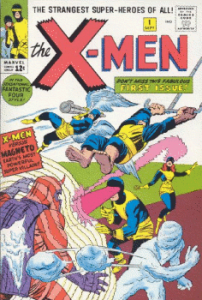 The X-Men #1 (Sept. 1963). Written by Stan Lee with art by Jack Kirby.
The X-Men #1 (Sept. 1963). Written by Stan Lee with art by Jack Kirby.
In early 1963, with the success of Spider-Man inAmazing Fantasy, as well as the Hulk, Thor, Iron Man, and the Fantastic Four, creator Stan Leedevised the series title after Marvel publisher Martin Goodman turned down the initial name, “The Mutants”, stating that readers would not know what a “mutant” was. Within the Marvel Universe, the X-Men are widely regarded to have been named afterProfessor Xavier himself. Xavier however claims that the name “X-Men” was never chosen to be a self-tribute. The name is also linked to the “X-Gene,” an unknown gene that causes the mutant evolution. The original explanation for the name, as provided by Xavier, is that mutants “possess an extra power… one which ordinary humans do not!! That is why I call my students… X-Men, for EX-tra power.”
Early X-Men issues introduced the team’s archenemy Magneto and his Brotherhood of Evil Mutants featuring Mastermind, Quicksilver, Scarlet Witch, and Toad. The comic focused on a common human theme of good versus evil and later included storylines and themes about prejudice and racism, all of which have persisted throughout the series in one form or another. The evil side in the fight was shown in human form and under some sympathetic beginnings via Magneto, a character who was later revealed to have survived Nazi concentration camps only to pursue a hatred for normal humanity. His key followers, Quicksilver and the Scarlet Witch, were Roma (gypsies). Only one new member of the X-Men was added, Mimic/Calvin Rankin, but soon left due to his temporary loss of power.
The title lagged in sales behind Marvel’s other comic franchises. In 1969, writer Roy Thomas and illustrator Neal Adams rejuvenated the comic book and gave regular roles to two recently introduced characters: Havok/Alex Summers (who had been introduced by Roy Thomas before Adams began work on the comic) and Lorna Dane, later called Polaris (created by Arnold Drake and Jim Steranko). However, these later X-Men issues failed to attract sales and Marvel stopped producing new stories with issue #66, later reprinting a number of the older comics as issues #67–93.
In Giant-Size X-Men #1 (1975), writer Len Wein and artist Dave Cockrum introduced a new team that then starred in a revival of The X-Men, beginning with issue #94. This new team, however, differed greatly from the original. Unlike in the early issues of the original series, the new team was not made up of teenagers and they also had a more diverse background. Each was from a different country with varying cultural and philosophical beliefs, and all were already well-versed in using their mutant powers, several being experienced in combat. The “all-new, all-different X-Men” were led by Cyclops from the original team and consisted of the newly created Colossus (from the Soviet Union), Nightcrawler (from West Germany), Storm (from Kenya), and Thunderbird (a Native American from the Apache nation), along with three previously introduced characters, Banshee (from Ireland), Sunfire (from Japan), and Wolverine (from Canada), who eventually became the breakout character on the team and, in terms of comic sales and appearances, the most popular X-Men character. A revamped Jean Grey soon rejoined the X-Men as the popular Phoenix; Angel, Beast, Havok, and Polaris also made significant guest appearances.
The revived series was illustrated by Cockrum, and later by John Byrne, and written by Chris Claremont. Claremont became the series’ longest-running contributor. The run met with critical acclaim and produced such early storylines as the death of Thunderbird, the return of the Sentinels and the emergence of Phoenix, the saga of the Starjammers and the fight for control of the M’Kraan Crystal, the resurrection of Garokk the Petrified Man, the introduction of Alpha Flight and the Proteus saga. Other characters introduced during this time include Amanda Sefton, Multiple Man, Mystique, and Moira MacTaggert with her genetic research facility on Muir Island.
The 1980’s began with the comic’s best-known story arc, the Dark Phoenix Saga, which saw Phoenix manipulated by the illusionist Mastermind and becoming corrupted with an overwhelming lust for power and destruction as the evil Dark Phoenix. Other important storylines included Days of Future Past, the saga of Deathbird and the Brood, the discovery of the Morlocks, the invasion of the Dire Wraiths and The Trial of Magneto, as well as X-Men: God Loves, Man Kills, the partial inspiration for the 2003 movie X2: X-Men United.
By the early 1980s, X-Men was Marvel’s top-selling comic title. Its sales were such that distributors and retailers began using an “X-Men index”, rating each comic book publication by how many orders it garnered compared to that month’s issue of X-Men. The growing popularity of Uncanny X-Men and the rise of comic book specialty stores led to the introduction of a number of ongoing spin-off series nicknamed “X-Books.” The first of these was The New Mutants, soon followed by Alpha Flight, X-Factor, Excalibur, and a solo Wolverine title. When Claremont conceived a story arc, the Mutant Massacre, which was too long to run in the monthlyX-Men, editor Louise Simonson decided to have it overlap into several X-Books. The story was a major financial success, and when the later Fall of the Mutants was similarly successful, the marketing department declared that the X-Men lineup would hold such crossovers annually.
Throughout the decade, Uncanny X-Men was written solely by Chris Claremont, and illustrated for long runs by John Byrne, Dave Cockrum, Paul Smith, John Romita, Jr., and Marc Silvestri. Additions to the X-Men during this time were Kitty Pryde/Shadowcat, Dazzler, Forge, Longshot, Psylocke, Rogue, Rachel Summers/Phoenix, and Jubilee. In a controversial move, Professor X relocated to outer space to be with Lilandra, Majestrix of the Shi’ar Empire, in 1986. Magneto then joined the X-Men in Xavier’s place and became the director of the New Mutants. This period also included the emergence of the Hellfire Club, the arrival of the mysterious Madelyne Pryor, and the villains Apocalypse, Mister Sinister, Mojo, and Sabretooth.
1990’s
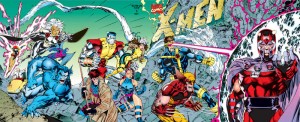 The multiple, interlocking covers of X-Men, vol. 2 #1 (1991). Art by Jim Lee.
The multiple, interlocking covers of X-Men, vol. 2 #1 (1991). Art by Jim Lee.
In 1991, Marvel revised the entire lineup of X-Books, centered on the launch of a second X-Men series, simply titled X-Men. With the return of Xavier and the original X-Men to the team, the roster was split into two strike forces: Cyclops’ “Blue Team” (chronicled in X-Men) and Storm’s “Gold Team” (in Uncanny X-Men).
Its first issues were written by longstanding X-Men writer Chris Claremont and drawn and co-plotted by Jim Lee. Retailers pre-ordered this book at 8 million copies, but probably sold closer to 3 million copies. Another new X-book released at the time was X-Force, featuring the characters fromThe New Mutants, led by Cable; it was written by Rob Liefeld and Fabian Nicieza. Internal friction soon split the X-books’ creative teams. In a controversial move, X-Men editor Bob Harras sided with Lee (and Uncanny X-Men artist Whilce Portacio) over Claremont in a dispute over plotting. Claremont left after only three issues of X-Men, ending his 16-year run as X-Men writer. Marvel replaced Claremont briefly with John Byrne, who scripted both books for a few issues. Byrne was then replaced by Nicieza and Scott Lobdell, who would take over the majority of writing duties for the X-Men until Lee’s own departure months later when he and several other popular artists (including former X-title artists Liefeld, Portacio, and Marc Silvestri) would leave Marvel to form Image Comics. Jim Lee’s X-Men designs would be the basis for much of the X-Men animated series and action figure line as well as several Capcom video games.
The 1990’s saw an even greater number of X-books with numerous ongoing series and miniseries running concurrently. X-book crossovers continued to run annually, with “The X-Tinction Agenda” in 1990, “The Muir Island Saga” in 1991, “X-Cutioner’s Song” in 1992, “Fatal Attractions” in 1993, “Phalanx Covenant” in 1994, “Legion Quest”/”Age of Apocalypse” in 1995, “Onslaught” in 1996, and “Operation: Zero Tolerance” in 1997. Though the frequent crossovers were criticized by fans as well as editorial and creative staff for being artificially regular, disruptive to the direction of the individual series, and having far less lasting impact than promised, they continued to be financially successful. There were many new popular additions to the X-Men including Cable, Bishop, and Gambit—who became one of the most popular X-Men (rivaling even Wolverine in size of fanbase), but many of the later additions to the team came and went (Joseph, Maggott, Marrow, Cecilia Reyes, and a new Thunderbird). Xavier’s New Mutants grew up and became X-Force, and the next generation of students began with Generation X, featuring Jubilee and other teenage mutants led and schooled by Banshee and former villainess Emma Frost at her Massachusetts Academy. In 1998, Excalibur and X-Factor ended and the latter was replaced with Mutant X, starring Havok stranded in a parallel universe. Marvel launched a number of solo series, including Deadpool, Cable, Bishop, X-Man, and Gambit, but few of the series would survive the decade.
In the 2000s, Claremont returned to Marvel and was put back on the primary X-Men titles during the Revolution event. He was soon removed from the two flagship titles in early 2001 and created his own spin-off series, X-Treme X-Men, which debuted a few months after his departure.
X-Men had its title changed at this time to New X-Men and new writer Grant Morrison took over. This era is often referred to as the Morrison-era, due to the drastic changes he made to the series, beginning with “E Is For Extinction,” where a new villainess, Cassandra Nova, destroys Genosha, killing sixteen million mutants. Morrison also brought reformed ex-villainess Emma Frost into the primary X-Men team, and opened the doors of the school by having Xavier “out” himself to the public about being a mutant. The bright spandex costumes that had become iconic over the previous decades were also gone, replaced by black leather street clothes reminiscent of the uniforms of the X-Men movies. Morrison also added a new character, Xorn, who would figure prominently in the climax of the writer’s run. In the meantime, Ultimate X-Men was launched, set in Marvel’s revised imprint. Chuck Austen also began his controversial run on Uncanny X-Men.
Notable additions to the X-Men have been Chamber, Emma Frost, Husk, Northstar, Armor, Pixie, and Warpath. During this decade former villains such as Juggernaut, Lady Mastermind, Mystique, and Sabretooth became members of the X-Men for various lengths of time. Several short-lived spin-offs and miniseries started featuring several X-Men in solo series, such as Emma Frost, Gambit,Mystique, Nightcrawler, and Rogue. Another book, Exiles, started at the same time and concluded in December 2007 but with a new book in January 2008, “New Exiles” written by Chris Claremont. Cable and Deadpool’s books were also rolled into one book, called Cable & Deadpool. A third core X-Men title was also introduced called Astonishing X-Men, written by Buffy the Vampire Slayer creator Joss Whedon, following Morrison’s departure. Another X-Book titled New X-Men: Academy X took its place focusing on the lives of the new young mutants at the Institute.
This period included the resurrections of Colossus and Psylocke, a new death for Jean Grey, who later returned temporarily in theX-Men: Phoenix – Endsong miniseries, as well as Emma Frost becoming the new headmistress of the Institute, a position that was formerly Jean Grey’s before her death. The Institute formerly ran as a large-scale school, until the depowering of most of the mutant population. It now serves as a safe haven to those mutants who are still powered, and as the home of the X-Men.
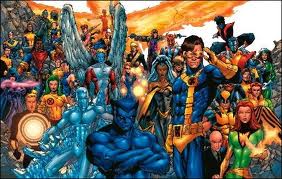 The 2007–2008 Messiah Complex crossover saw the destruction of the Xavier Institute and the disbanding of the X-Men. Out of the crossover spun the new volumes of X-Force, following the team led by Wolverine, and Cable, following Cable’s attempts at protecting the Messiah child. X-Men, vol. 2 was renamed into X-Men: Legacy and will focus on Professor Xavier, Rogue and Gambit. The main team later reformed in Uncanny X-Men #500, with the X-Men now operating out of a new base in San Francisco under Cyclops’s leadership. Uncanny X-Men returned to its roots as the flagship title for the X-Franchise and served as the umbrella under which the various X-Books co-exist.
The 2007–2008 Messiah Complex crossover saw the destruction of the Xavier Institute and the disbanding of the X-Men. Out of the crossover spun the new volumes of X-Force, following the team led by Wolverine, and Cable, following Cable’s attempts at protecting the Messiah child. X-Men, vol. 2 was renamed into X-Men: Legacy and will focus on Professor Xavier, Rogue and Gambit. The main team later reformed in Uncanny X-Men #500, with the X-Men now operating out of a new base in San Francisco under Cyclops’s leadership. Uncanny X-Men returned to its roots as the flagship title for the X-Franchise and served as the umbrella under which the various X-Books co-exist.
A crossover between X-Force and Cable series entitled Messiah War, written by Craig Kyle and Chris Yost, commenced in March 2009 and served as a second part in the trilogy that began with Messiah Complex. Matt Fraction also wrote a Dark Avengers/Uncanny X-Men crossover, Utopia, running through summer 2009, as a part of the larger Dark Reign storyline. 2009 also saw the beginning of the new New Mutants volume written by Zeb Wells, with the limited series X-Infernus serving as prologue. The new volume saw some of the more prominent members of the original team reunited.
The end of 2009 and the Nation X storyline saw the X-Men’s longtime archnemesis, Magneto, renouncing his villainous ways and joining the X-Men, which Cyclops allowed. This was much to the dismay of other members of the X-Men, such as Beast, who left the team in disgust. Magneto began to work with Namor to transform Utopia into a homeland for both mutants and Atlanteans.
Starting with issue #226, Rogue became the main character of X-Men: Legacy. The new series direction began in the X-Men: Legacy Annual after the conclusion of Utopia. X-Force, New Mutants, and X-Men: Legacy were also involved in Necrosha, a crossover in which Selene resurrected all the mutants killed in the Genosha massacre. X-Force contained the main storyline, while the other series handled the consequences of the prologue one-shot.
Notable story arcs of this decade are “Revolution” (2000), “Eve of Destruction,” “E Is For Extinction” (2001), “Planet X,” “Here Comes Tomorrow,” “Gifted,” (2004) X-Men: Phoenix – Endsong, “House of M,” “Decimation” (2005), Deadly Genesis (2005–2006), “Endangered Species” (2007), “Messiah Complex” (2007–2008), “Divided We Stand” (2008), “Manifest Destiny” (2008–2009), X-Infernus, “Messiah War,” “Utopia,” “Nation X” and “Necrosha” (2009). The X-Men were also involved in the “Secret Invasion” storyline.
Notable story arcs of this decade include the 2010 storyline “Second Coming“, based on plot threads from “Messiah Complex” and “House of M,” “Age of X“, and “Schism” (2011), as well as “Avengers vs. X-Men” (2012), which finally resolved the storylines stemming from “House of M” and “Decimation”, and ended with the death of Professor X and new mutants once again appearing.
The beginning of the decade also saw the relaunching of a few X-Men titles, including a new volume of X-Men: Legacy and two volumes each of Uncanny X-Force (continued from X-Force vol. 3), X-Men, and the long-running Uncanny X-Men. New Mutants was cancelled in 2012 and a new X-Force series, Cable and X-Force was added to the lineup.
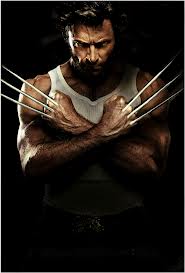 In the aftermath of the Schism series, the fallout between Wolverine and Cyclops led to the revival and rebuilding of the original X-Mansion by Wolverine, with support from Kitty Pryde, Iceman, Rogue, and Beast. The school, the Jean Grey School for Higher Learning, was featured in a new series Wolverine and the X-Men.
In the aftermath of the Schism series, the fallout between Wolverine and Cyclops led to the revival and rebuilding of the original X-Mansion by Wolverine, with support from Kitty Pryde, Iceman, Rogue, and Beast. The school, the Jean Grey School for Higher Learning, was featured in a new series Wolverine and the X-Men.
In 2012, as part of the Marvel NOW! relaunch, Marvel released a new ongoing series by Rick Remender and John Cassaday titled the Uncanny Avengers, which featured a team of Avengers and X-Men members initially led by Havok. A few weeks later, a new flagship X-Men series, All-New X-Men by Brian Michael Bendis and Stuart Immonen, was launched. The series featured the original five X-Men being brought to the present time by Beast in order to stop Cyclops and his team, who have become fugitives after the “Avengers vs. X-Men” event and are gathering new mutants at a rapid pace while promoting a “mutant revolution”. The relaunchedUncanny X-Men, vol. 3 feature Cyclops, his team, and the new mutants, who have taken up residency in the Weapon X facility, which they have rebuilt into a school named the New Charles Xavier’s School for Mutants.
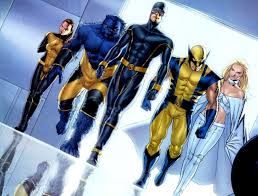 World of the X-Men – History of the X-Men comics – Mutant (Marvel Comics)
World of the X-Men – History of the X-Men comics – Mutant (Marvel Comics)
The X-Men exist in the Marvel Universe with other characters portrayed in Marvel Comics series. As such, it is unsurprising that they often meet characters from other series, and the global nature of the mutant concept means the scale of stories can be highly varied.
The X-Men fight everything ranging from mutant thieves to galactic threats. Historically, the X-Men have been based in the Xavier Institute, near Salem Center, in north-east Westchester County, NY, and are often depicted as a family. The X-Mansion is often depicted with three floors and two underground levels. To the outside world, it had acted as a higher learning institute until the 2000s, when Xavier was publicly exposed as a mutant at which point it became a full mutant boarding school. Xavier funds a corporation aimed at reaching mutants worldwide, though it ceased to exist following the “Decimation.”
The X-Men benefit greatly from state-of-the-art technology. For example, Xavier is depicted tracking down mutants with a device called Cerebro which amplifies his powers; the X-Men train within the Danger Room, first depicted as a room full of weapons and booby traps, now as generating holographic simulations; and the X-Men travel in their widely recognized and iconic Blackbird jet.
The X-Men introduced several fictional locations which are regarded as important within the shared universe in which Marvel Comics characters exist:
- Asteroid M, an asteroid made by Magneto, a mutant utopia and training facility off of the Earth’s surface.
- Genosha, an island near Madagascar and a longtime apartheid regime against mutants. Given control by the U.N. to Magneto until the E Is for Extinction story.
- Madripoor, an island in South East Asia, near Singapore. Its location is shown to be in the southern portion of the Strait of Malacca, south west of Singapore.
- Muir Island, a remote island off the coast of Scotland. This is primarily known in the X-Men universe as the home of Moira MacTaggert‘s laboratory.
- Mutant Town (also known as District X), an area in Alphabet City, Manhattan, populated largely by mutants and beset by poverty and crime.
- Savage Land, a preserved location in Antarctica which is home to a number of extinct species, most notably dinosaurs.
- Utopia, Cyclops had Asteroid M raised from the Pacific Ocean off the coast of the San Francisco as a response to the rise of anti-mutant sentiment to form a new Mutant Nation.

